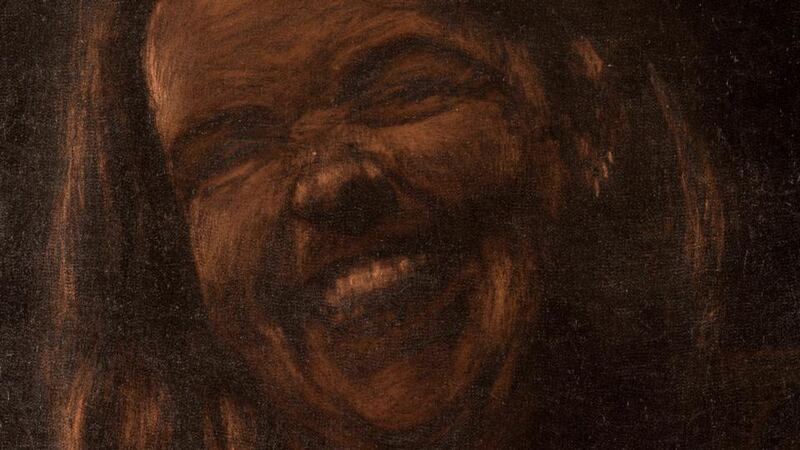Season and Evening and Weather and History – Caoimhe Kilfeather (Gallery 1)
Turkmen and Uzbek Children's Clothes (Gallery 2)
Douglas Hyde Gallery, Trinity College Dublin
★★★★
Caoimhe Kilfeather is one of several younger Irish artists who have shown a keen interest in expanding the material tradition of sculpture. She studied at NCAD in Dublin and at the Slade in London and has received several bursaries, scholarships and awards. Over the past decade or so she has become a significant presence in Irish art, exhibiting regularly and widely. Now she tackles the formidable space of the Douglas Hyde Gallery, where her almost entirely monochromatic work, in the form of photographs and three-dimensional pieces, is paired with a bracingly colourful display of Turkmen and Uzbek infant and children's clothing in Gallery 2.
There is a linking work by Kilfeather, a beautiful little piece in which fine strands of copper and steel wire are woven to create a shimmering textural surface. Its relative brightness prepares us for the busy coloured patterns of the children’s garments, which are amazing to see. They were made throughout the 20th century, as mass- produced Russian cotton replaced traditional handwoven fabrics. But the skill and artistry of the anonymous women who made the clothes remained strongly in evidence. As you might expect of cultures long steeped in textile expertise, the patterns, colours and textures are superbly well integrated and boldly inventive.


Kilfeather's work, by contrast, is severely muted and elegiac, almost funereal, with the gallery lights deliberately kept low. The Douglas Hyde's director, John Hutchinson, argues that, in her approach, the utopian aspirations of modernism are infused with the melancholia of high romanticism. He points to TS Eliot's bitter-sweet evocation of a world that was, a past that underlies the fragmentation and anxiety of modernity.
It has often been stated that Kilfeather is interested in the legacies inherent in particular materials, forms, and modes of manufacture. These legacies, she implies, haunt the apparent familiarity and ordinariness of the world we’ve made around us. Ambitiously, her show is close to being one continuous installation. A series of photographs featuring details of a large formal garden (unnamed, but the little accompanying publication includes a photograph of Killruddery in Co Wicklow) punctuate the layout. They have the darkness-made- visible quality of Craigie Horsfield’s work. As Hutchinson describes it, Kilfeather goes for the liminal, in-between state of dusk or dawn, a space of transition and becoming. Formal hedges enclose avenues. The air is grey and misty.
In a sense, these intermittent images transform the gallery into the formal garden. You make your way through it and encounter various objects. They have a functional air, but often that function remains puzzlingly unclear. There’s a big table, a bit clunky and awkward, made from scorched larch, and a miniature set of stairs or seats, as though taken from an amphitheatre. Lumpy cast-iron forms are suspended in a group. Several heaps of glittering, tempered steel ballast fragments are distributed throughout.
A sheet of polished, coloured plaster has a watery sheen: a particularly evocative image in the overall context. Polished coal is a staple material for Kilfeather, and there’s an example here: a flying saucer-like, bulbous disc form, partly crumbled, brought to earth. The artist’s intention seems to be to draw us into a space, an environment that is a kind of maze. Once we’re in the maze, we encounter objects that we sort of recognise, but not quite. Things resonate, but usually confound our expectations. Once you are okay with not quite knowing where you are or what you’re looking at, you might well find the experience stimulating and rewarding.
- Until July 27th
National Self-Portrait Collection Additions 2016 – Various artists
Bourn Vincent Gallery, University of Limerick
★★★★
Each year UL’s National Self-Portrait Collection unveils new additions in a summer-long display. The collection, which was established in 1983, has grown to almost 500 pieces. Its reach is broad, extending back to John Butts’s self-portrait from 1760 to younger established contemporary artists. It becomes increasingly difficult to acquire historical works, so it makes sense to be carefully attentive to contemporary art. If you miss out on someone now, it can only get harder to add him or her later on.
This year's additions include the abstract painter John Noel Smith. He offered not an abstract but a dramatic chiaroscuro study made when he was 19 years old. Gabhann Dunne's informal, joyous Little Kisses has the appearance of a fleeting snapshot. An outstanding graphic artist, Pamela Dunne's lustrous study is, ingeniously, not a print but a plate: the mezzotint copperplate, inked so we can read the richly textured image against the glow of the metal. Mosaic artists Maeve and Nicholas Kinney have strong associations with UL and each offered a mosaic self-portrait in vitreous glass.
Although Mary O'Dea, who worked as an engineer before she turned to art, is probably best known as a printmaker, she opted for a sculptural installation, a fine visualisation of an individual as enmeshed in myriad networks. The Friends of the National Collections donated a striking work by Róisín Murray (1894-1980). Murray, a member of Cumann na mBan and a student of Seán Keating's, later exhibited under the name Róisín O'Doherty. Although she resisted offers of solo shows from Leo Smith, she completed commissions until the mid-1970s.
- Until September 30th, ul.ie/visualarts













